Master of Business Administration (PDF)
VerifiedAdded on 2021/06/22
|6
|1915
|94
AI Summary
Contribute Materials
Your contribution can guide someone’s learning journey. Share your
documents today.
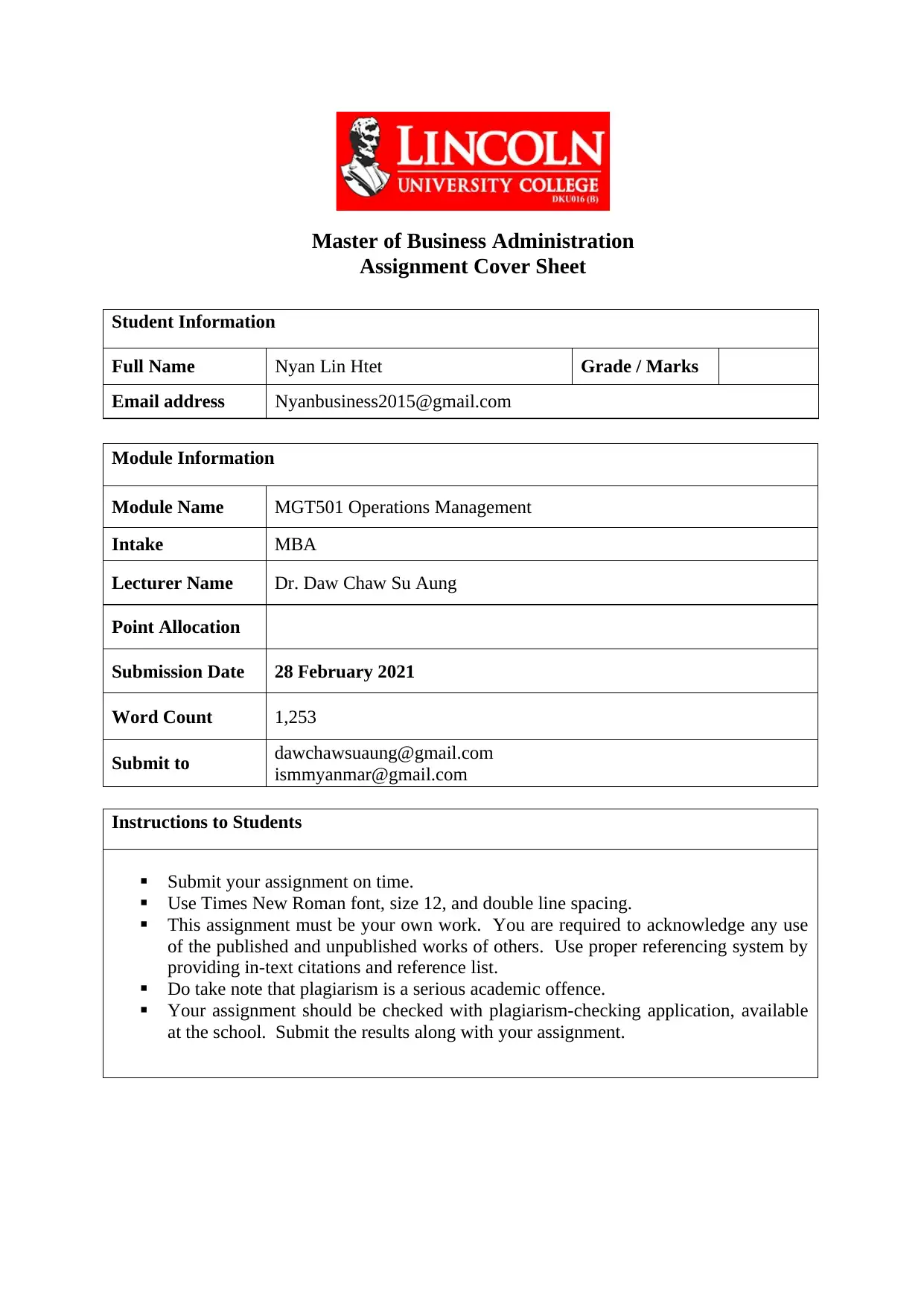
Master of Business Administration
Assignment Cover Sheet
Student Information
Full Name Nyan Lin Htet Grade / Marks
Email address Nyanbusiness2015@gmail.com
Module Information
Module Name MGT501 Operations Management
Intake MBA
Lecturer Name Dr. Daw Chaw Su Aung
Point Allocation
Submission Date 28 February 2021
Word Count 1,253
Submit to dawchawsuaung@gmail.com
ismmyanmar@gmail.com
Instructions to Students
Submit your assignment on time.
Use Times New Roman font, size 12, and double line spacing.
This assignment must be your own work. You are required to acknowledge any use
of the published and unpublished works of others. Use proper referencing system by
providing in-text citations and reference list.
Do take note that plagiarism is a serious academic offence.
Your assignment should be checked with plagiarism-checking application, available
at the school. Submit the results along with your assignment.
Assignment Cover Sheet
Student Information
Full Name Nyan Lin Htet Grade / Marks
Email address Nyanbusiness2015@gmail.com
Module Information
Module Name MGT501 Operations Management
Intake MBA
Lecturer Name Dr. Daw Chaw Su Aung
Point Allocation
Submission Date 28 February 2021
Word Count 1,253
Submit to dawchawsuaung@gmail.com
ismmyanmar@gmail.com
Instructions to Students
Submit your assignment on time.
Use Times New Roman font, size 12, and double line spacing.
This assignment must be your own work. You are required to acknowledge any use
of the published and unpublished works of others. Use proper referencing system by
providing in-text citations and reference list.
Do take note that plagiarism is a serious academic offence.
Your assignment should be checked with plagiarism-checking application, available
at the school. Submit the results along with your assignment.
Secure Best Marks with AI Grader
Need help grading? Try our AI Grader for instant feedback on your assignments.
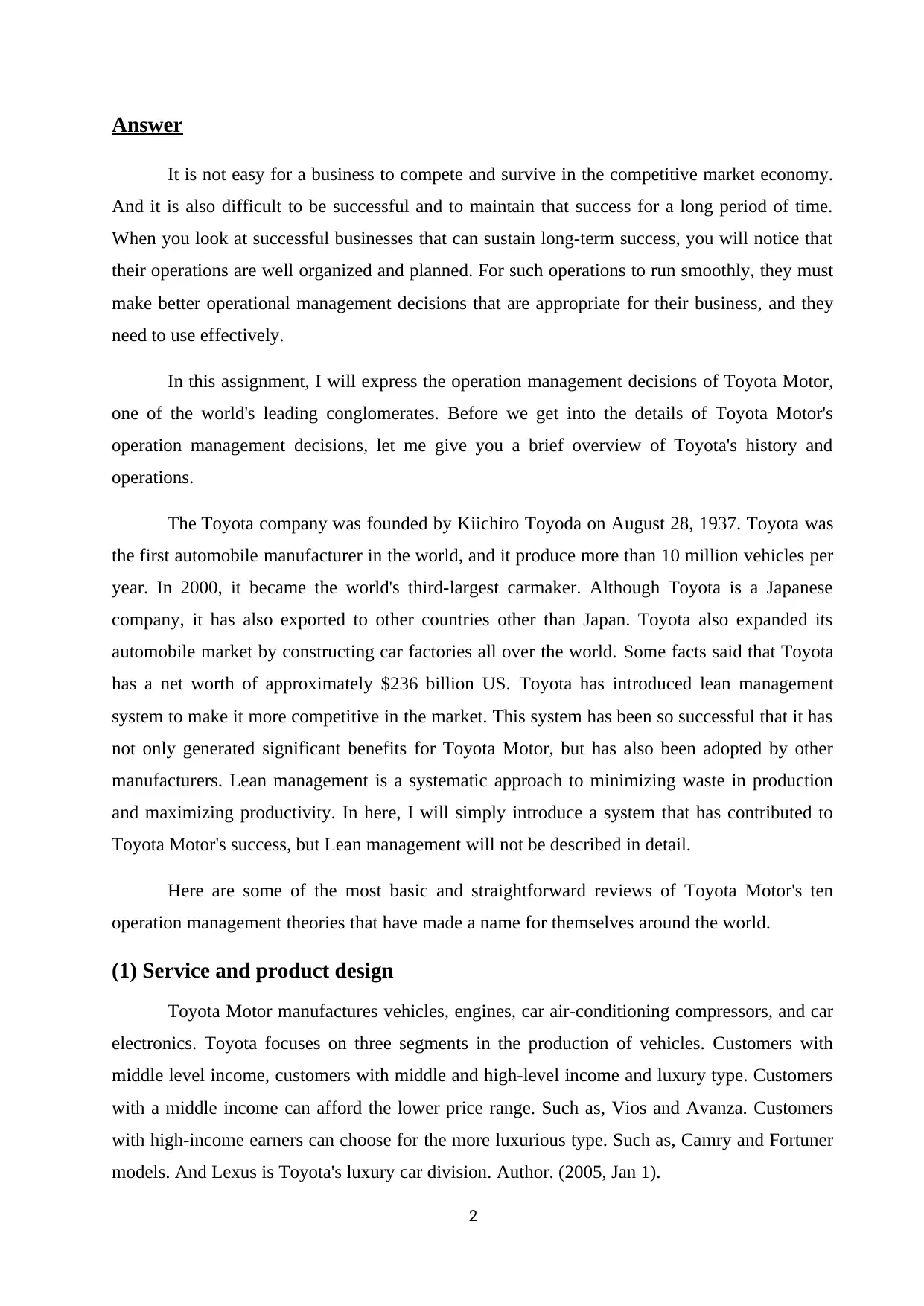
Answer
It is not easy for a business to compete and survive in the competitive market economy.
And it is also difficult to be successful and to maintain that success for a long period of time.
When you look at successful businesses that can sustain long-term success, you will notice that
their operations are well organized and planned. For such operations to run smoothly, they must
make better operational management decisions that are appropriate for their business, and they
need to use effectively.
In this assignment, I will express the operation management decisions of Toyota Motor,
one of the world's leading conglomerates. Before we get into the details of Toyota Motor's
operation management decisions, let me give you a brief overview of Toyota's history and
operations.
The Toyota company was founded by Kiichiro Toyoda on August 28, 1937. Toyota was
the first automobile manufacturer in the world, and it produce more than 10 million vehicles per
year. In 2000, it became the world's third-largest carmaker. Although Toyota is a Japanese
company, it has also exported to other countries other than Japan. Toyota also expanded its
automobile market by constructing car factories all over the world. Some facts said that Toyota
has a net worth of approximately $236 billion US. Toyota has introduced lean management
system to make it more competitive in the market. This system has been so successful that it has
not only generated significant benefits for Toyota Motor, but has also been adopted by other
manufacturers. Lean management is a systematic approach to minimizing waste in production
and maximizing productivity. In here, I will simply introduce a system that has contributed to
Toyota Motor's success, but Lean management will not be described in detail.
Here are some of the most basic and straightforward reviews of Toyota Motor's ten
operation management theories that have made a name for themselves around the world.
(1) Service and product design
Toyota Motor manufactures vehicles, engines, car air-conditioning compressors, and car
electronics. Toyota focuses on three segments in the production of vehicles. Customers with
middle level income, customers with middle and high-level income and luxury type. Customers
with a middle income can afford the lower price range. Such as, Vios and Avanza. Customers
with high-income earners can choose for the more luxurious type. Such as, Camry and Fortuner
models. And Lexus is Toyota's luxury car division. Author. (2005, Jan 1).
2
It is not easy for a business to compete and survive in the competitive market economy.
And it is also difficult to be successful and to maintain that success for a long period of time.
When you look at successful businesses that can sustain long-term success, you will notice that
their operations are well organized and planned. For such operations to run smoothly, they must
make better operational management decisions that are appropriate for their business, and they
need to use effectively.
In this assignment, I will express the operation management decisions of Toyota Motor,
one of the world's leading conglomerates. Before we get into the details of Toyota Motor's
operation management decisions, let me give you a brief overview of Toyota's history and
operations.
The Toyota company was founded by Kiichiro Toyoda on August 28, 1937. Toyota was
the first automobile manufacturer in the world, and it produce more than 10 million vehicles per
year. In 2000, it became the world's third-largest carmaker. Although Toyota is a Japanese
company, it has also exported to other countries other than Japan. Toyota also expanded its
automobile market by constructing car factories all over the world. Some facts said that Toyota
has a net worth of approximately $236 billion US. Toyota has introduced lean management
system to make it more competitive in the market. This system has been so successful that it has
not only generated significant benefits for Toyota Motor, but has also been adopted by other
manufacturers. Lean management is a systematic approach to minimizing waste in production
and maximizing productivity. In here, I will simply introduce a system that has contributed to
Toyota Motor's success, but Lean management will not be described in detail.
Here are some of the most basic and straightforward reviews of Toyota Motor's ten
operation management theories that have made a name for themselves around the world.
(1) Service and product design
Toyota Motor manufactures vehicles, engines, car air-conditioning compressors, and car
electronics. Toyota focuses on three segments in the production of vehicles. Customers with
middle level income, customers with middle and high-level income and luxury type. Customers
with a middle income can afford the lower price range. Such as, Vios and Avanza. Customers
with high-income earners can choose for the more luxurious type. Such as, Camry and Fortuner
models. And Lexus is Toyota's luxury car division. Author. (2005, Jan 1).
2
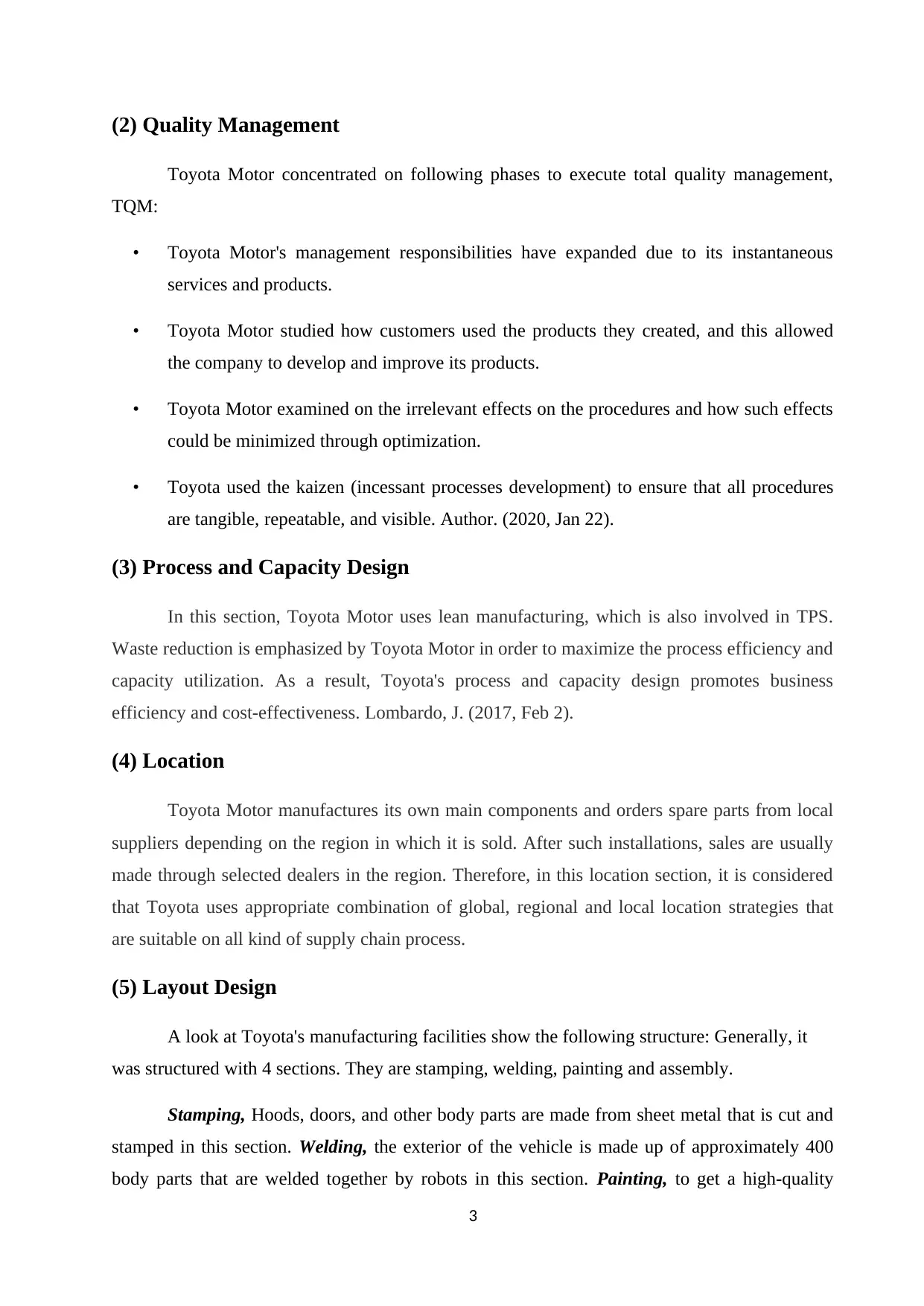
(2) Quality Management
Toyota Motor concentrated on following phases to execute total quality management,
TQM:
• Toyota Motor's management responsibilities have expanded due to its instantaneous
services and products.
• Toyota Motor studied how customers used the products they created, and this allowed
the company to develop and improve its products.
• Toyota Motor examined on the irrelevant effects on the procedures and how such effects
could be minimized through optimization.
• Toyota used the kaizen (incessant processes development) to ensure that all procedures
are tangible, repeatable, and visible. Author. (2020, Jan 22).
(3) Process and Capacity Design
In this section, Toyota Motor uses lean manufacturing, which is also involved in TPS.
Waste reduction is emphasized by Toyota Motor in order to maximize the process efficiency and
capacity utilization. As a result, Toyota's process and capacity design promotes business
efficiency and cost-effectiveness. Lombardo, J. (2017, Feb 2).
(4) Location
Toyota Motor manufactures its own main components and orders spare parts from local
suppliers depending on the region in which it is sold. After such installations, sales are usually
made through selected dealers in the region. Therefore, in this location section, it is considered
that Toyota uses appropriate combination of global, regional and local location strategies that
are suitable on all kind of supply chain process.
(5) Layout Design
A look at Toyota's manufacturing facilities show the following structure: Generally, it
was structured with 4 sections. They are stamping, welding, painting and assembly.
Stamping, Hoods, doors, and other body parts are made from sheet metal that is cut and
stamped in this section. Welding, the exterior of the vehicle is made up of approximately 400
body parts that are welded together by robots in this section. Painting, to get a high-quality
3
Toyota Motor concentrated on following phases to execute total quality management,
TQM:
• Toyota Motor's management responsibilities have expanded due to its instantaneous
services and products.
• Toyota Motor studied how customers used the products they created, and this allowed
the company to develop and improve its products.
• Toyota Motor examined on the irrelevant effects on the procedures and how such effects
could be minimized through optimization.
• Toyota used the kaizen (incessant processes development) to ensure that all procedures
are tangible, repeatable, and visible. Author. (2020, Jan 22).
(3) Process and Capacity Design
In this section, Toyota Motor uses lean manufacturing, which is also involved in TPS.
Waste reduction is emphasized by Toyota Motor in order to maximize the process efficiency and
capacity utilization. As a result, Toyota's process and capacity design promotes business
efficiency and cost-effectiveness. Lombardo, J. (2017, Feb 2).
(4) Location
Toyota Motor manufactures its own main components and orders spare parts from local
suppliers depending on the region in which it is sold. After such installations, sales are usually
made through selected dealers in the region. Therefore, in this location section, it is considered
that Toyota uses appropriate combination of global, regional and local location strategies that
are suitable on all kind of supply chain process.
(5) Layout Design
A look at Toyota's manufacturing facilities show the following structure: Generally, it
was structured with 4 sections. They are stamping, welding, painting and assembly.
Stamping, Hoods, doors, and other body parts are made from sheet metal that is cut and
stamped in this section. Welding, the exterior of the vehicle is made up of approximately 400
body parts that are welded together by robots in this section. Painting, to get a high-quality
3
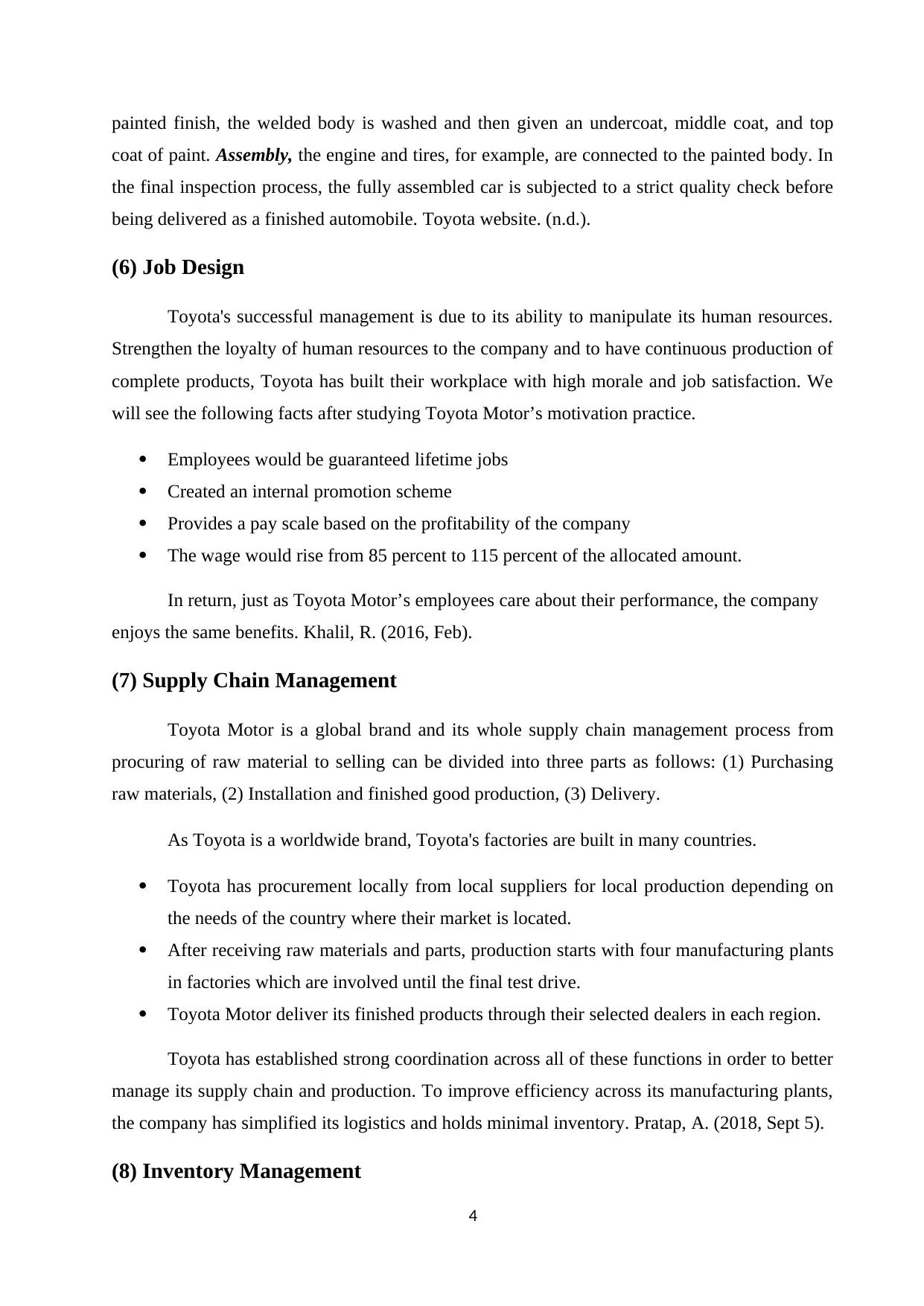
painted finish, the welded body is washed and then given an undercoat, middle coat, and top
coat of paint. Assembly, the engine and tires, for example, are connected to the painted body. In
the final inspection process, the fully assembled car is subjected to a strict quality check before
being delivered as a finished automobile. Toyota website. (n.d.).
(6) Job Design
Toyota's successful management is due to its ability to manipulate its human resources.
Strengthen the loyalty of human resources to the company and to have continuous production of
complete products, Toyota has built their workplace with high morale and job satisfaction. We
will see the following facts after studying Toyota Motor’s motivation practice.
Employees would be guaranteed lifetime jobs
Created an internal promotion scheme
Provides a pay scale based on the profitability of the company
The wage would rise from 85 percent to 115 percent of the allocated amount.
In return, just as Toyota Motor’s employees care about their performance, the company
enjoys the same benefits. Khalil, R. (2016, Feb).
(7) Supply Chain Management
Toyota Motor is a global brand and its whole supply chain management process from
procuring of raw material to selling can be divided into three parts as follows: (1) Purchasing
raw materials, (2) Installation and finished good production, (3) Delivery.
As Toyota is a worldwide brand, Toyota's factories are built in many countries.
Toyota has procurement locally from local suppliers for local production depending on
the needs of the country where their market is located.
After receiving raw materials and parts, production starts with four manufacturing plants
in factories which are involved until the final test drive.
Toyota Motor deliver its finished products through their selected dealers in each region.
Toyota has established strong coordination across all of these functions in order to better
manage its supply chain and production. To improve efficiency across its manufacturing plants,
the company has simplified its logistics and holds minimal inventory. Pratap, A. (2018, Sept 5).
(8) Inventory Management
4
coat of paint. Assembly, the engine and tires, for example, are connected to the painted body. In
the final inspection process, the fully assembled car is subjected to a strict quality check before
being delivered as a finished automobile. Toyota website. (n.d.).
(6) Job Design
Toyota's successful management is due to its ability to manipulate its human resources.
Strengthen the loyalty of human resources to the company and to have continuous production of
complete products, Toyota has built their workplace with high morale and job satisfaction. We
will see the following facts after studying Toyota Motor’s motivation practice.
Employees would be guaranteed lifetime jobs
Created an internal promotion scheme
Provides a pay scale based on the profitability of the company
The wage would rise from 85 percent to 115 percent of the allocated amount.
In return, just as Toyota Motor’s employees care about their performance, the company
enjoys the same benefits. Khalil, R. (2016, Feb).
(7) Supply Chain Management
Toyota Motor is a global brand and its whole supply chain management process from
procuring of raw material to selling can be divided into three parts as follows: (1) Purchasing
raw materials, (2) Installation and finished good production, (3) Delivery.
As Toyota is a worldwide brand, Toyota's factories are built in many countries.
Toyota has procurement locally from local suppliers for local production depending on
the needs of the country where their market is located.
After receiving raw materials and parts, production starts with four manufacturing plants
in factories which are involved until the final test drive.
Toyota Motor deliver its finished products through their selected dealers in each region.
Toyota has established strong coordination across all of these functions in order to better
manage its supply chain and production. To improve efficiency across its manufacturing plants,
the company has simplified its logistics and holds minimal inventory. Pratap, A. (2018, Sept 5).
(8) Inventory Management
4
Secure Best Marks with AI Grader
Need help grading? Try our AI Grader for instant feedback on your assignments.
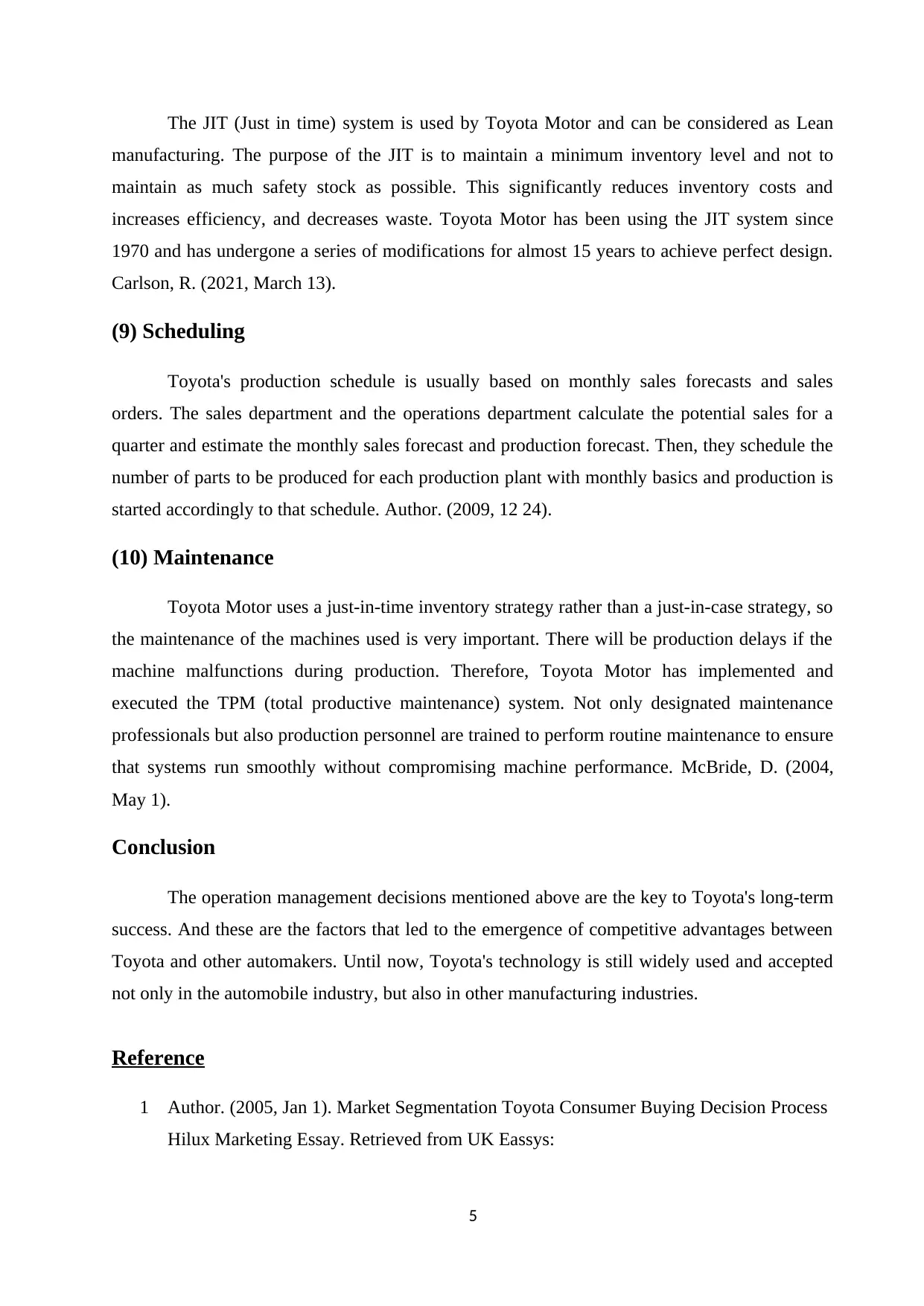
The JIT (Just in time) system is used by Toyota Motor and can be considered as Lean
manufacturing. The purpose of the JIT is to maintain a minimum inventory level and not to
maintain as much safety stock as possible. This significantly reduces inventory costs and
increases efficiency, and decreases waste. Toyota Motor has been using the JIT system since
1970 and has undergone a series of modifications for almost 15 years to achieve perfect design.
Carlson, R. (2021, March 13).
(9) Scheduling
Toyota's production schedule is usually based on monthly sales forecasts and sales
orders. The sales department and the operations department calculate the potential sales for a
quarter and estimate the monthly sales forecast and production forecast. Then, they schedule the
number of parts to be produced for each production plant with monthly basics and production is
started accordingly to that schedule. Author. (2009, 12 24).
(10) Maintenance
Toyota Motor uses a just-in-time inventory strategy rather than a just-in-case strategy, so
the maintenance of the machines used is very important. There will be production delays if the
machine malfunctions during production. Therefore, Toyota Motor has implemented and
executed the TPM (total productive maintenance) system. Not only designated maintenance
professionals but also production personnel are trained to perform routine maintenance to ensure
that systems run smoothly without compromising machine performance. McBride, D. (2004,
May 1).
Conclusion
The operation management decisions mentioned above are the key to Toyota's long-term
success. And these are the factors that led to the emergence of competitive advantages between
Toyota and other automakers. Until now, Toyota's technology is still widely used and accepted
not only in the automobile industry, but also in other manufacturing industries.
Reference
1 Author. (2005, Jan 1). Market Segmentation Toyota Consumer Buying Decision Process
Hilux Marketing Essay. Retrieved from UK Eassys:
5
manufacturing. The purpose of the JIT is to maintain a minimum inventory level and not to
maintain as much safety stock as possible. This significantly reduces inventory costs and
increases efficiency, and decreases waste. Toyota Motor has been using the JIT system since
1970 and has undergone a series of modifications for almost 15 years to achieve perfect design.
Carlson, R. (2021, March 13).
(9) Scheduling
Toyota's production schedule is usually based on monthly sales forecasts and sales
orders. The sales department and the operations department calculate the potential sales for a
quarter and estimate the monthly sales forecast and production forecast. Then, they schedule the
number of parts to be produced for each production plant with monthly basics and production is
started accordingly to that schedule. Author. (2009, 12 24).
(10) Maintenance
Toyota Motor uses a just-in-time inventory strategy rather than a just-in-case strategy, so
the maintenance of the machines used is very important. There will be production delays if the
machine malfunctions during production. Therefore, Toyota Motor has implemented and
executed the TPM (total productive maintenance) system. Not only designated maintenance
professionals but also production personnel are trained to perform routine maintenance to ensure
that systems run smoothly without compromising machine performance. McBride, D. (2004,
May 1).
Conclusion
The operation management decisions mentioned above are the key to Toyota's long-term
success. And these are the factors that led to the emergence of competitive advantages between
Toyota and other automakers. Until now, Toyota's technology is still widely used and accepted
not only in the automobile industry, but also in other manufacturing industries.
Reference
1 Author. (2005, Jan 1). Market Segmentation Toyota Consumer Buying Decision Process
Hilux Marketing Essay. Retrieved from UK Eassys:
5
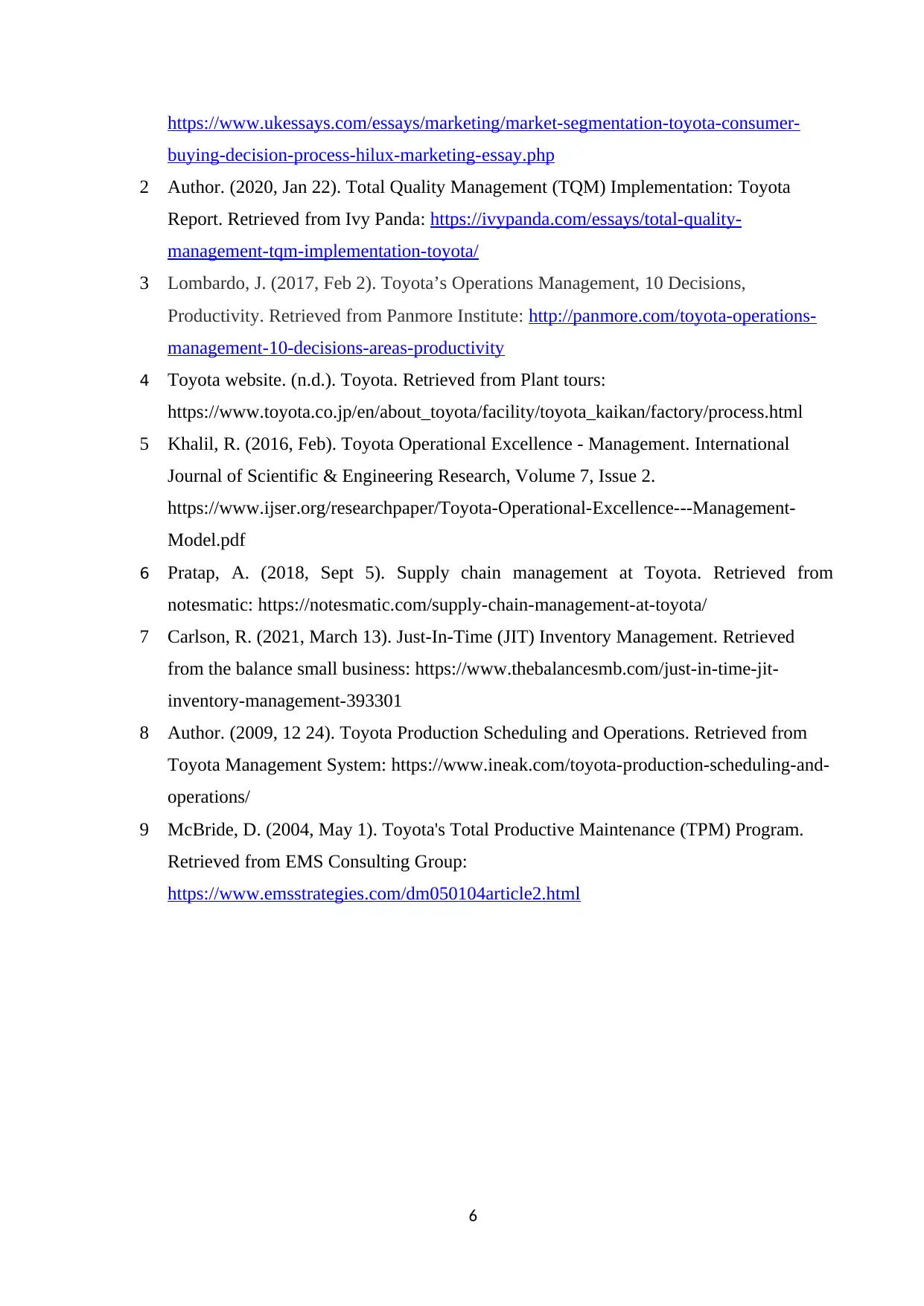
https://www.ukessays.com/essays/marketing/market-segmentation-toyota-consumer-
buying-decision-process-hilux-marketing-essay.php
2 Author. (2020, Jan 22). Total Quality Management (TQM) Implementation: Toyota
Report. Retrieved from Ivy Panda: https://ivypanda.com/essays/total-quality-
management-tqm-implementation-toyota/
3 Lombardo, J. (2017, Feb 2). Toyota’s Operations Management, 10 Decisions,
Productivity. Retrieved from Panmore Institute: http://panmore.com/toyota-operations-
management-10-decisions-areas-productivity
4 Toyota website. (n.d.). Toyota. Retrieved from Plant tours:
https://www.toyota.co.jp/en/about_toyota/facility/toyota_kaikan/factory/process.html
5 Khalil, R. (2016, Feb). Toyota Operational Excellence - Management. International
Journal of Scientific & Engineering Research, Volume 7, Issue 2.
https://www.ijser.org/researchpaper/Toyota-Operational-Excellence---Management-
Model.pdf
6 Pratap, A. (2018, Sept 5). Supply chain management at Toyota. Retrieved from
notesmatic: https://notesmatic.com/supply-chain-management-at-toyota/
7 Carlson, R. (2021, March 13). Just-In-Time (JIT) Inventory Management. Retrieved
from the balance small business: https://www.thebalancesmb.com/just-in-time-jit-
inventory-management-393301
8 Author. (2009, 12 24). Toyota Production Scheduling and Operations. Retrieved from
Toyota Management System: https://www.ineak.com/toyota-production-scheduling-and-
operations/
9 McBride, D. (2004, May 1). Toyota's Total Productive Maintenance (TPM) Program.
Retrieved from EMS Consulting Group:
https://www.emsstrategies.com/dm050104article2.html
6
buying-decision-process-hilux-marketing-essay.php
2 Author. (2020, Jan 22). Total Quality Management (TQM) Implementation: Toyota
Report. Retrieved from Ivy Panda: https://ivypanda.com/essays/total-quality-
management-tqm-implementation-toyota/
3 Lombardo, J. (2017, Feb 2). Toyota’s Operations Management, 10 Decisions,
Productivity. Retrieved from Panmore Institute: http://panmore.com/toyota-operations-
management-10-decisions-areas-productivity
4 Toyota website. (n.d.). Toyota. Retrieved from Plant tours:
https://www.toyota.co.jp/en/about_toyota/facility/toyota_kaikan/factory/process.html
5 Khalil, R. (2016, Feb). Toyota Operational Excellence - Management. International
Journal of Scientific & Engineering Research, Volume 7, Issue 2.
https://www.ijser.org/researchpaper/Toyota-Operational-Excellence---Management-
Model.pdf
6 Pratap, A. (2018, Sept 5). Supply chain management at Toyota. Retrieved from
notesmatic: https://notesmatic.com/supply-chain-management-at-toyota/
7 Carlson, R. (2021, March 13). Just-In-Time (JIT) Inventory Management. Retrieved
from the balance small business: https://www.thebalancesmb.com/just-in-time-jit-
inventory-management-393301
8 Author. (2009, 12 24). Toyota Production Scheduling and Operations. Retrieved from
Toyota Management System: https://www.ineak.com/toyota-production-scheduling-and-
operations/
9 McBride, D. (2004, May 1). Toyota's Total Productive Maintenance (TPM) Program.
Retrieved from EMS Consulting Group:
https://www.emsstrategies.com/dm050104article2.html
6
1 out of 6
Related Documents
Your All-in-One AI-Powered Toolkit for Academic Success.
+13062052269
info@desklib.com
Available 24*7 on WhatsApp / Email
![[object Object]](/_next/static/media/star-bottom.7253800d.svg)
Unlock your academic potential
© 2024 | Zucol Services PVT LTD | All rights reserved.





